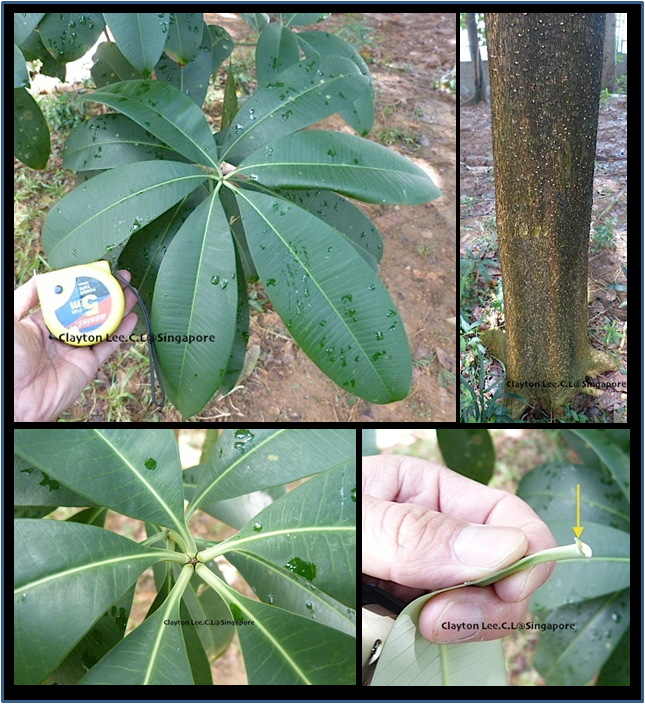Alstonia scholaris (L.) R.Br., Mem. Wern. Nat. Hist. Soc. 1: 76 76 (1810)
Species name meaning 'used for schools', referring to the use of the wood for school blackboards in Java.Synonyms
Echites scholaris L.
Pala scholaris (L.) Roberty
Tabernaemontana alternifolia Burm.
Diagnostics
Large trees with light wood and lots of white sap when cut. Leaves in whorls, with each leaf possessing
a distinct ligule at base of petiole (similar to Araliaceae); leaf lower surface whitish, secondary
veins placed close together and almost perpendicular to the mid-vein. Produces large, elongate, paired
fruits (green-blackish) which contain many small seeds with tufts of hears on two sides of each seed for
wind dispersal.
Description
A medium-sized to large tree 10-50(-60) m tall, bole cylindrical, in older trees massively fluted,
up to 125 cm in diameter, with stout buttresses up to 10 m tall which spread out at the base for up
to 4 m, outer bark brown or yellowish-white, smooth but coming off evenly in small papery flakes, with
horizontally enlarged lenticels and hoops, inner bark yellow to brown, usually tinged yellowish, with
copious white latex; leaves in whorls of 4-8(-9), narrowly elliptical to obovate, (5-)6-17(-22) cm x
(1.5-)2.5-7.5(-8.5) cm, apex obtuse or rounded, with 25-45(-55) pairs of secondary veins, petiole
5-20(-25) mm long; inflorescence mostly formed of dense bunches of flowers, many-flowered, pedicel
0-2 mm long, calyx pubescent, corolla pubescent outside; follicles glabrous. [from PROSEA]
Ecology
Most abundant in monsoon areas, and it tolerates various soils and habitats, including secondary
vegetation. It occurs from sea-level up to about 1250 m altitude.
Distribution
The most widely distributed Alstonia species, found from Sri Lanka and India through mainland
South-East Asia and southern China, throughout Malesia, to northern Australia, the Bismarck Archipelago
and the Solomon Islands. It has been planted elsewhere.
Uses
In the Philippines, a decoction of the bark is used as a febrifuge and tonic, as an emmenagogue,
anticholeric and vulnerary. The latex is applied to ulcers and for rheumatic pains. In Thailand,
the bark is used as an antidysenteric, astringent, and a remedy for colds and bronchitis. In Indo-China,
the bark is used as a strengthening tonic, a febrifuge, in the treatment of abdominal pains, irregular
menstruation, dysentery, diarrhoea and arthritis. A decoction is applied as a wash for skin diseases,
and as a gargle. It is believed to be a galactagogue, but this may well be an example of doctrine of
signs. In Papua New Guinea, the leaves or bark are widely used as a febrifuge, to relieve stomach
complaints, diarrhoea and dysentery. The latex is drunk in small amounts as a poison antidote. Mention
is made of its use for coughs, asthma, pneumonia and lung cancer, gout, and hypertension. In New Britain,
bark sap squeezed into water is occasionally drunk to combat anaemia. Bark sap, drunk three times daily,
is said to induce abortion. Trobriand Island girls chew the leaves as an oral contraceptive. A poultice
made from the leaves has been reported as a good remedy against skin diseases. Alstonia scholaris
is the most important source of pulai timber. The latex also provides a good-quality chewing gum.
The tree is sometimes planted as an ornamental. In Java the wood was formerly used for school blackboards,
hence the name 'scholaris'.
Local names
Brunei: pulai lilin.
Burma (Myanmar): taung meok, lettok.
English: White cheesewood, milkwood, blackboard tree.
French: Shaitan.
Indonesia: pulai (general), pule (Javanese), rite (Ambon).
Laos: tinpet.
Malaysia: pulai (Peninsular), kacau gitik (Kiput, Sarawak).
Papua New Guinea: katung (Buang, Morobe Province), kambuu (Kanganaman, Sepik Province),
herina (Hisui, Central Province).
Philippines: dita (Tagalog, Bikul, Sulu), dalipaoen (Iloko), tanitan (Bisaya).
Thailand: sattaban, tin pet (central), hassaban (southwestern).
Vietnam: m[of] cua, s[uwx]a.
